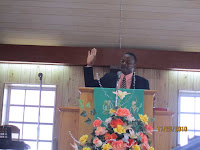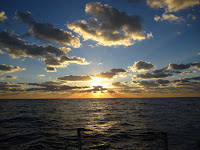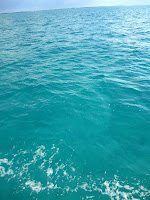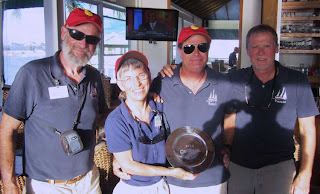Due to the tragic loss of one of the vessels and a crew member in the caribbean1500 it is difficult to continue our narrative without interweaving the tales and outcomes. It is part of the drama which separates our current endeavor from the day to day life, snug at home. I will try to pick up our trip from Cape Fear to the sunny shores of Abaco filling in some of the events and factors which enrich and explain the experience. I dedicate this to Laura Zekoll, a sailor from Atlanta, lost and presumed drowned and to the crew of “Rule 62” who survived.
There are two flotillas in the Caribbean 1500. The first and oldest is the 1500 mile passage from Hampton Virginia to Tortola, BVI (British Virgin Islands.) Started by Steve Black, a solo ocean voyager 21 years ago, thousands of Sailors have safely crossed the gulfstream in company of others. This year there were seventy sailboats in this group. With a November first departure date, most have just arrived there, or are arriving as I type. Steve is retiring this year, and passing the baton.
The second flotilla is the Bahamas 800 which includes Bentaña, our “ship” with crew of four and sailing cat Mary. We were nine boats and the event is only a few years old. We chose the Bahamas group for several reasons. Bentaña has made the trip about twenty times with former owners Tom and Sandy Stefanic, and ship’s cat Sailin’ Waylon. We have already sailed in the BVI, and wanted to chart some new territory. Thirdly, our insurer, BOAT/US does not cover south of the Bahamas.
Probably the best reason is that over the years our journey towards this trip has been incremental. Starting with an Ensign, 23’ day sailor, learning sailboat handling and gaining skills over five or six years, and chartering and cruising with our good friends Jon and Carol Marsh. We moved up to a Tartan 30 and made trips in the company of other boats, and eventually solo. Now we have made this trip with others and have some idea of what to expect. We sent Dave Otterbein home yesterday, and now it’s up to Judy and me to sail the Bahamas on our own. Longer passages and terra incognita loom in the future.
Each of the flotillas is further divided into cruisers and ralleyers, with the ralleyers classed by size. Ralleyers met up off shore from Hampton Roads for a timed PHRF handicapped run to Charleston SC. The “Plan,” (always subject to change) was to sail directly out and through the Gulf Stream in the first day directly to the Bahamas. Because November One marks the first day after official hurricane season, insurance restrictions are lifted and the rally begins, weather permitting. This year, remnants of “Thomas” nixed the off-shore venture, but allowed a weather window for the Bahamas group to make tracks south to Charlestown and await another window. This would put the group half-way to Marsh Harbor and possibly avoid any delay. The 1500 group would have to sit tight, as their track was further east and would be impacted by poor weather. The prudent sailor requires pretty good conditions before setting out to the open ocean. The 1500 group sat for a week in Hampton chomping at the bit. For the owners and crew, many of whom have day jobs, the charm and novelty of Hampton wears thin. Several boats have decided to head out on their own.
Steve Black and his wonderful crew of volunteer inspectors, trainers and hosts bend over backwards to make this a safe and enjoyable adventure. After a rigorous inspection of each boat, rig, equipment and crew, we are reminded that the choice to go off-shore ultimately lies with us. The dangers inherent in this venture are neither overblown nor minimized.
…And so 0900 11-01-10 the ralleyers meet on open waters west of the Chesapeake Bay Bridge / Tunnel. Bernie, our group leader, on Mahalo said “OK we’re all here, we’ve started.” So with Bentaña at the back of the pack, we’re off. Our PHRF handicap gives us an 18 hour advantage over the fastest boat in the trip to Charleston, but in the first few hours we pass two boats. For the rest of the day the boats seemed to be in lock step, with the boat in front of us never getting closer or further away. With the winds from the NW we were reaching into the night in good wind and fair seas. Now we were following a double stern light, both the tri-color and deck nav light being turned on on the boat before us, easy to follow, but against regulations.
Overnight the winds grew and the sea swells as well. We continued to gain on the fleet as the hours wore on. The seas became confused, with cross swells pushing our bow one way and stern another. We began Racing down waves and veering east and west. Our new auto-pilot groaned as she tried to keep us on course in tormenting seas. Finally she failed, and gave up the wheel to the watch. I looked into the engine room and saw the chain and gears lying on the deck. Holding oneself steady was a chore, but trying to do a task was near impossible. We were in it, and the way out of it was to hand steer till conditions improved.
Conditions would not improve for a couple of days, in fact were forecast to get worse. The four of us, in two watches sailed around the clock, three hours on and three hours off, day and night. While many of the boats reported on our twice daily radio net rendezvous that they were motoring, we had come to sail, and sail we did. We continued to pass boats, and had we not decided to duck into Wilmington NC, I’m sure we would have scored first,
The decision to go to Wilmington was based on our utter exhaustion, and no respite in sight. The three hours on watch was a grind, physically and mentally. Seasickness was not an issue, but the constant erratic motion of the ship, wracking and pitching without letup made sleeping near impossible and staying awake as hard. Of the three hours between watches, it took half an hour getting in and out of foul weather gear. It was cold and wet in the dark blue waters of the Labrador Current influence. Once lying horizontal (relatively,) the groan of the woodwork writhing in the torsion of the seaway, and the feel of your guts sloshing around in your abdomen, rolling from side to side in your bunk …oh well you get the picture. Managing the wheel was tough as the wind had clocked behind us. With our sails reefed and preventer on, the boat when steering down wind was on the constant edge of jibing. Too little to the left and the sail would back with a bang, only the robust preventer keeping it from swinging across and breaking the gooseneck. A little too much to the right and the apparent wind would pick the boat up and turn it east to the shoals. Bringing it back from one of these lifters was an act of brute force, wrestling 11 tons of fiberglass back on track, only to swing one way or the other on the next wave. The seas were running 15 foot swells and winds at 20-30 kts with gusts to 40. The constant backing and filling also cost us a batten, as the pocket snagged on the lower aft main shroud and ripped the pocket open. If this wasn’t enough, continuing to Charleston would mean at least one more day of this, and potentially ever building seas.
Furthermore Dave Otterbein’s folks live at Shipwatch on the River and are mariners through and through. Harry, Dave’s dad, was following our track on the web site (carib1500.com) and saw us come around Frying Pan Shoals and heading up the Cape Fear River and called out, “Carol, I think we’re going to have company.” It took half the night rounding the Frying Pan Shoals Light,(not found) and up the Cape Fear River, the entry to Wilmington, a major commercial seaport. The river is wide but shoaly and the chart plotter and Nav aids vital. At daylight, cell access restored, Harry had found us a slip and a sail maker. Bone weary rest ensued.
I assure you we could not have had a better R& R &R. , but that is a story for another day. We were in contact with the fleet in Charleston, and we were all awaiting another weather window several days off. Meanwhile the race was over without us, and they were spending all our banquet money without us. The auto-pilot had failed by the backing out of a twenty five cent set screw. No damage to any parts. The sailmaker, Lars from Blue Water Canvas Works was able to turn the work around overnight, and our main has all four new velcroed Batten Pockets. Dave bemoaned the lack of leecloths on the settee, so we found a fabric shop with sunbrella and he built a pair for the boat. The port deck level nav light had also failed and let water into the chain locker and vee-berth so Harry rebuilt that.
As delightful as our time ashore, we were anxious to get going. We had given Tim shore leave on the proviso that he rejoins the ship before departure. I wasn’t sure if the first leg was the kind of adventure he had signed on for. He lives in Charleston and we thought we might go down the ICW (Inter Coastal Waterway) and all get together there. Dave who is the most experienced sailor on board suggested we could meet the fleet on the other side of the Gulf Stream and enter the Bahamas together. Bernie had the same idea and also told us we had earned a trophy for perseverance in extraordinary circumstances (not to mention that we passed him close by on the water and would have beaten all the monohulls to the finish. IMHO.)
And so it was, all delays aside, we rowed out to Bentaña, anchored on Otter Creek in Carol and Dave’s Walker Bay dink. We brought the ship to a vacant slip next to Carol Ann, the Otterbein’s Motor cruiser. Tim rejoined us and we took some shut-eye, awaiting the midnight tide and another round of watch on watch.
It is the nature of water, a fluid which covers most of the globe to be in motion in relation to the sun, the moon, the rotation of the earth, the spinning of the aqueous gyres and the ever fluctuating wind. The size and direction of sea swells is a factor of the force and duration of the wind. The longer the fetch and longer the duration, the higher water will mound up. When we left Cape Fear the seas had settled, and a moderate breeze was fine as we approached the Gulf Stream. Here further south, the stream is more constricted than at Hampton, and subsequently travels northerly off shore at a higher speed. The best plan of attack is to enter after a low pressure event, which should give several days of quiet seas,. Once in the stream, sail or motor perpendicular to the stream as to reach the other side in the shortest time. While going across the stream, the vessel is being carried north, giving the inclination to head south for our Waypoint in the islands. This tack will only prolong the time spent in the stream with the dangers this may produce. With the winds behind us again, and the auto pilot still not functioning we crossed the stream by next day. We doffed our foulies and hauled on the shorts. The air temperature was up, the water temperature which we gauged hourly was at 90 degrees. The seas were a new color, translucent blue-green with sarragasso weed floating on the waves.
In a couple of more days we would rendezvous with the rest of the fleet and enter the Bahamas as a group. Since leaving Hampton, the fleet has morphed. Some boats have hitched along with us, and some faster cats have headed south on their own. Boats which sustained damage or unbearable conditions in the first leg turned back or down the coast. Unknown to our fleet, Rule 62 had left the BVI fleet and was headed for the Bahamas.
A little geography is in order here. The BVIs, like most of the Caribbean, is volcanic, as or as my friend Captain Curt Koster the engineer is fond of saying, “It’s binary.” Islands rise from the sea like mountains with deep water close at hand. This is not the case for the Bahamas. The four hundred or so islands and cays stretch for miles across a shallow limestone bank. In a way that is its charm. You sail in waters no more than 15 feet deep, and see the bottom as you go. The islands have little rise to them, but provide a barrier to the great ocean swells that can and unfortunately did arise this week. Entry to the islands is restricted as at an atoll, to certain passages and only in certain conditions. As Bernie advised us approaching the rendezvous, “If your depth gauge says 300 feet, you are too close.” The Bahamas banks rise abruptly from a thousand feet of water to a dozen or more. If you have contended with The Race, or Hell’s Gate, you can imagine the consequences. The charts recommends as did Bernie, enter at daylight , to make your way in when the suns angle is good for reading the water. GPS and Charts must be used in conjunction with a bow watch, depth sounder and hands on the wheel. Shoaling waters, sand bars and unreliable bouyage are part of the challenge. The morning we entered, conditions on the ocean were deteriorating. Besides staying off-shore till daybreak, in the conditions that where to come, it would have been advisable to remain off-shore till things settled down. Plain and simple, sometimes you cannot enter.
It seems from the transponder record on the web site, Rule 62 was on track for an entrance at eight PM Saturday. The transponder which only reports every four hours, next showed them off course and on a reef at midnight. The three survivors reported that after going aground on the reef, they deployed the life raft and all four of crew got in the raft with life jackets on. Apparently the raft overturned, all four fell out, they were separated and three were washed ashore.
Lynyard Cay, like many of these Cays is an off shore Barrier, similar to Fire island, that is with a quiet side and an ocean side. The loss was unknown to us when we anchored at Hope Town, on the protected side. We climbed the short bluff to see the ocean side. Locals told us that the condition they call a “rage” was worse than people could remember. We took pictures of the surf crashing on the reef and enjoyed rum drinks as the sun set. We saw a helicopter pass.
Clearly some bad decisions were made on board Rule 62, but I wasn’t there. I too have been tossed around as if inside a washing machine for hours on end. A desperate attempt for shore against unknown days being bashed about at sea. What would you do?
Steph 11-17-10
























